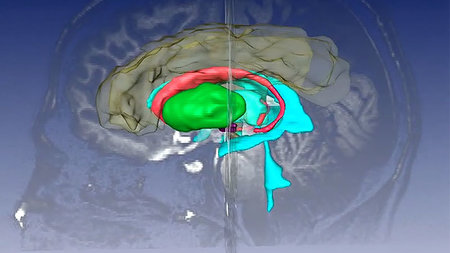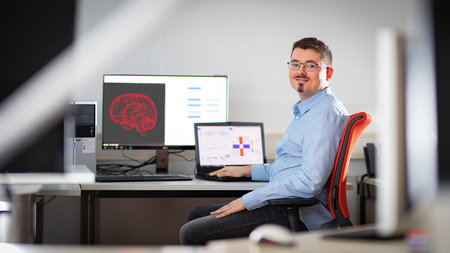Neurokognition II
SS2019
Prüfungstermine
Die Prüfungen zur Neurokognition finden zu folgenden Terminen statt: Anmeldungen bitte direkt an Frau Susan Köhler, susan.koehler@informatik.tu-chemnitz.de. |
Inhalte
Die Veranstaltung führt in die Modellierung neurokognitiver Vorgänge des Gehirns ein. Neurokognition ist ein Forschungsfeld, welches an der Schnittstelle zwischen Psychologie, Neurowissenschaft, Informatik und Physik angesiedelt ist. Es dient zum Verständnis des Gehirns auf der einen Seite und der Entwicklung intelligenter adaptiver Systeme auf der anderen Seite. Die Neurokognition II beleuchtet komplexere Modelle von Neuro-psychologischen Prozessen, mit dem Ziel neue Algorithmen für intelligente, kognitive Roboter zu entwickeln. Themen sind Wahrnehmung, Gedächtnis, Handlungskontrolle, Emotionen, Entscheidungen und Raumwahrnehmung. Zum tieferen Verständnis erfordern die Übungen auch praktische Aufgaben am Rechner.
Randbedingungen
Empfohlene Voraussetzungen: Grundkenntnisse Mathematik I bis IV, Neurokognition I
Prüfung: Mündliche Prüfung
Ziele: Fachspezifische Kenntnisse der Neurokognition
Syllabus
Part I Introduction
The introduction motivates the goals of the course and basic concepts of models. It further explains why computational models are useful to understand the brain and why cognitive computational models can lead to a new approach in modeling truly intelligent agents.
The styles of computation used by biological systems are fundamentally different from those used by conventional computers: biological neural networks process information using energy-efficient asynchronous, event-driven, methods. They learn from their interactions with the environment, and can flexibly produce complex behaviors. These biological abilities yield a potentially attractive alternative to conventional computing strategies.
Neurokognition II is particularly devoted to model perception cognition and behavior in large-scale neural networks. The course introduces models of early vision, attention, object recognition, space perception, cognitive control, memory, emotion and consciousness.
Exercise I.1: Tutorial on the neuro-simulator ANNarchy, files: exerciseI.1.zip.
Part II Early Vision
Perhaps our most important sensory information about our environment is vision. The lecture "early vision" explains the first processing steps of visual perception.
Overview:DeAngelis, G., Ohzawa, I., Freeman, R.D. (1995): Receptive-field dynamics in the central visual pathways. TINS Vol. 18, No. 10, 1995
Vision starts in the retina, which is considered part of the brain. The lecture explains the concept of a receptive field and introduces simple models of early processing that model dynamic receptive fields.
Additional Reading:Shape perception refers to the fact that the visual system has filters that respond optimally to oriented bars or edges, which takes place in area V1, also called striate cortex. This lecture introduces into the receptive fields of neurons in V1 and explains what kind of information V1 encodes with respect to shape perception.
Exercise II.1: Gabor filters, Files: exerciseII.1.zip
Color perception starts in the retina, since we have receptors that are selective for different wavelength of the light. This lecture introduces into models of color selective receptive fields.
In the cortex, the visual space is overrepresented in the fovea, which means that much more space in cortex is devoted to compute information around the center of visual space. A cortical magnification function allows to model the relation between visual and cortical space providing a method to account for the overrepresentation in models of visual perception.
Suggested Reading:
Motion perception begins already in area V1 by motion sensitive cells and then continues in the dorsal pathway in areas MT and MST.
Suggested Reading:
Seeing in three dimensions requires to extract depth information from the visual scene. One method, called binocular disparitiy, is of primary focus.
Suggested Reading:
Exercise II.2: Depth perception, Files: exerciseII.2.zip, solution Part B
Gain normalization appears to be a canonical neural computation in sensory systems and possibly also in other neural systems. Gain normalization is introduced and examples for normalization in retina, in primary visual cortex, in higher visual cortical areas and in non-visual cortical areas are given.
Suggested Reading:
Why does the brain develop a particular set of feature detectors for early vision. This lecture addresses how approaches that rely on learning allow to better understand the coding of vision in the brain.
Suggested Reading:
Teichmann, M., Wiltschut, J., Hamker, F.H. (2012) Learning invariance from natural images inspired by observations in the primary visual cortex. Neural Computation, 24: 1271-1296
Additional Reading:
Simoncelli, E.P.: Vision and the statistics of the visual environment. Current Opinion in Neurobiology 2003, 13:144-149.
Part III High-level Vision
High-level vision deals with questions of how we recognize objects or scenes and how we direct processing resources to particular aspects of visual scenes (visual attention).
3.1 Object recognitionObject recognition appears to be solved by a hierarchically organized system that progressively increases the complexity and invariance of feature detectors.
Suggested Reading:
Serre, T, Wolf, L, Bileschi, S, Riesenhuber, M, Poggio, T (2007) Object recognition with cortex-like mechanisms. In: IEEE Transactions on Pattern Analysis and MachineIntelligence, 29:411-426.
Exercise III.1: Object Recognition and HMAX, Files: exerciseIII.1.zip ; article: Serre, Wolf and Poggio (2004).
Attention refers to mechanisms that allow the focusing of processing resources. Experimental observations, neural principles and system-level models of attention are described.
Suggested Reading:
Reynolds JH, Heeger DJ (2009) The normalization model of attention. Neuron 61: 168-185.
Exercise III.2: Normalization model of
attention, Files: exerciseIII.2.zip solution Part B.
Exercise III.3: Visual attention and experimental data, Files: exerciseIII.3.zip .
The perception of space is very crucial for systems that interact with the world. This lecture introduces to anatomical pathways of space perception. The primary focus is then directed to the problem of "Visual Stability", which deals with the question of why we perceive a stable environment regardless that each eye movement changes the content on the retina.
Suggested Reading:
Hamker, F. H., Zirnsak, M., Ziesche, A., Lappe, M. (2011) Computational
models of spatial updating in peri-saccadic perception. Phil. Trans. R. Soc. B (2011), 366:
554-571.
Husain, M., Nachev, P. (2006) Space and the parietal cortex. Trends in Cognitive Sciences,
11:30-36.
Additional Material:
Setup for predictive remapping (left: fixation task, right: saccade task) over
time with respect to the three input signals (retinal signal (green), PC signal
(red) and CD signal (blue)): A stimulus is shown either in the receptive field
(RF; left) or in the future RF (FRF; right) while the eyes fixate the fixation
point (FP). In the saccade task, an eye movement is executed to the saccade
target (ST) afterwards. The green star depicts the current stimulus position,
the red cross symbolizes the current eye position. As the retinal signal and
the origin of the corollary discharge signal are retinotopic, they shift with
the eye movement. In contrast, the PC signal is head-centered and therefore
fixed during the saccade. The time in ms is aligned to saccade onset.
Setup for spatial updating of attention with cued attention over time with
respect to the three input signals (retinal signal (green), PC signal (red) and
CD signal (blue)): A stimulus is presented at the attention position (AP) while
the eyes fixate the fixation point (FP). Afterwards, an eye movement is
executed to the saccade target (ST). The green star depicts the current
stimulus position, the red cross symbolizes the current eye position. Place
markers for the remapped and the lingering attention position (RAP and LAP) are
shown. As the retinal signal and the origin of the corollary discharge signal
is retinotopic, it shifts with the eye movement. In contrast, the PC signal is
head-centered and therefore fixed during the saccade. The time in ms is aligned
to saccade onset.
Setup for spatial updating of attention with top-down attention over time with
respect to the three input signals (PC signal (red), CD signal (blue) and
attention signal (orange)): An eye movement is executed from the fixation point
(FP) to the saccade target (ST). During the whole process, top-down attention
is introduced at the attention position (AP). The red cross symbolizes the
current eye position. Place markers for the remapped and the lingering
attention position (RAP and LAP) are shown. The corollary discharge signal is
retinotopic, thus, it shifts with the eye movement. In contrast, PC signal and
attention signal are head-centered and therefore fixed during the saccade. The
time in ms is aligned to saccade onset.
Simulation results of the two predictive remapping tasks (fixation and saccade
task) over time. The activity of both LIP maps projected onto two
two-dimensional planes representing horizontal and vertical information as well
as the setup including the neural activities of both LIP maps projected into
the retinotopic space are plotted. In the fixation task, the projected activity
of LIP PC and LIP CD results in activity at RF (red and blue blob). In the
saccade task, the projected activity of LIP PC and LIP CD results in activity
at FRF (red and blue blob). Shortly before saccade onset, LIP CD triggers an
additional activity blob at RF (blue blob). Both activity blobs are encoded in
a retinotopic reference frame, thus, they move according to the eye movement.
The time in ms is aligned to saccade onset.
Simulation results of spatial updating of attention with cued attention over
time. The activity of both LIP maps projected onto two two-dimensional planes
representing horizontal and vertical information as well as the setup including
the neural activities of both LIP maps projected into the retinotopic space are
plotted. At the beginning, the activity in LIP PC and LIP CD triggers an
attention pointer at AP (red and blue blob). Shortly before saccade onset,
there is a second attention pointer triggered at RAP by LIP CD (blue blob).
Both attention pointers are shifted with the eye movement as they are
retinotopic. After the saccade, the CD signal decays and with it the activity
in LIP CD as well as the second attention pointer. Furthermore, the PC signal
updates to the correct postsaccadic eye position and thus, the attention
pointer triggered by LIP PC updates to the correct position (AP). The time in
ms is aligned to saccade onset.
Simulation results of spatial updating of attention with top-down attention over
time. The activity of both LIP maps projected onto two two-dimensional planes
representing horizontal and vertical information as well as the setup including
the neural activities of both LIP maps projected into the retinotopic space are
plotted. At the beginning, the activity in LIP PC triggers an attention pointer
at AP (red blob). Shortly before saccade onset, there is a second attention
pointer triggered at RAP by LIP CD (blue blob). Both attention pointers are
shifted with the eye movement as they are retinotopic. After the saccade, the
CD signal decays and with it the activity in LIP CD as well as the second
attention pointer. Furthermore, the PC signal updates to the correct
postsaccadic eye position and thus, the attention pointer triggered by LIP PC
updates to the correct position (AP). The time in ms is aligned to saccade
onset.
Exercise III.4: Space perception, Files: exerciseIII.4.zip, ANN Start Script
Part IV Cognition
Cognition deals with questions of how a system can learn and execute complex tasks and allow control over sensors and actions.
Suggested Reading:
4.2 Motor decision and Parkinson disease
Suggested Reading:
Wiecki, T.V., Frank, M.J. (2010) Neurocomputational models of motor and
cognitive deficits in Parkinson's disease. Prog. Brain Res. 183:275-297.
Suggested Reading:
Exercise IV.1: Basal ganglia, Files: exerciseIV.1.zip
Exercise IV.2: Hippocampus, Files: exerciseIV.2.zip
4.5 Cognition. Episodic Memory and Goals
-

Welche Schaltkreise im Gehirn bestimmen unser Alltagsverhalten?
Vom dualen System zum Netzwerk: Forschungsteam aus Chemnitz, Santiago de Chile und Magdeburg hat eine neue Sicht auf die Handlungssteuerung im Gehirn und ihren Nutzen für die Entwicklung neuroinspirierter KI …
-

Gehirn-Schluckauf besser verstehen
Projektstart für deutsch-israelisch-amerikanisches Kooperationsprojekt zur Erforschung von Tourette- Ursachen …
-

Mit SmartStart 2 auf dem Weg zur Promotion
Oliver Maith, der in Chemnitz Sensorik und kognitive Psychologie studierte, war in einem wettbewerblichen Verfahren zur Promotionsförderung erfolgreich und forscht nun im Bereich der Computational Neuroscience …
-

Erfolgreiche Bleibeverhandlungen mit Prof. Dr. Andreas Undisz
Inhaber der Professur Elektronenmikroskopie und Mikrostrukturanalytik an der TU Chemnitz wurde zum W3-Professor ernannt …
-
Zentrum für Wissens- und Technologietransfer CircEcon Grüne Kreislaufwirtschaft: Strukturwandel in der Lausitz
Der CircEcon-Campus in der sächsischen Lausitz ist ein neues …
-
Internationales Universitätszentrum Auslandsaufenthalte weltweit während des Studiums
Auslandssemester und -praktikum weltweit! Hole dir Informationen zu …
-
TU Chemnitz Tag der offenen Tür 2026
Welcher Studiengang passt zu mir? Welche Voraussetzungen muss ich erfüllen? Was kann ich neben dem …
-
Zentrum für Wissens- und Technologietransfer 50 Jahre Wohngebiet Fritz-Heckert Eine Stadt in der Stadt
Der Vortrag zeichnet die historische und städtebauliche Entstehung des …
-
Universitätsbibliothek 1. DVPW-Impuls-Tagung Weltordnung im Wandel Politikwissenschaft in …
Auf der 1. DVPW-Impuls-Tagung Weltordnung im Wandel wird diskutiert, wie …
-
Philosophische Fakultät Autokraten, Monarchen und Generäle Wie stabil sind die Staaten Nordafrikas?
Die nordafrikanischen Staaten ringen mit innerer Destabilisierung, Protest …

